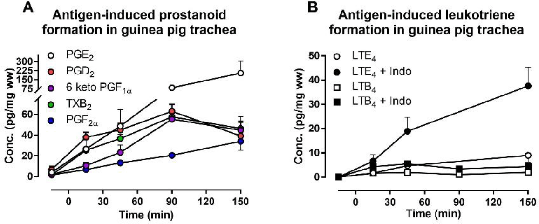Print version
Search Pub Med
| 220P London, UK Pharmacology 2017 |
Antigen challenge results in specific activation of classical pathways for arachidonic acid oxygenation
Introduction: Arachidonic acid (AA) and related membrane-bound poly-unsaturated fatty acid (PUFA) precursors may be transformed into numerous lipid mediators (LM) with many proposed biological functions. Their relative importance and occurrence however remains unclear. Here we assessed the profile of LM biosynthesis during antigen-challenge of the guinea pig trachea, a model resembling human airways (1).
Method: An ultra-performance liquid chromatography (UPLC)-tandem mass spectrometry (MS-MS) platform monitoring 112 metabolites of the major PUFA-pathways catalysed by lipoxygenases (LOX), cyclo-oxygenases (COX), P-450 cytochromes, as well as non-enzymatic lipid peroxidation products and isoprostanes was used to analyse bath fluid withdrawn from functional experiments (n=96) on tracheas from guinea pigs sensitized to ovalbumin (OVA).
Results: At baseline, before challenge with OVA, 62 compounds representing most pathways were detected at levels ranging between 0.1-5 pg per mg tissue wet weight (pg/mg). Challenge with a bolus dose of OVA (100 μg/mL) induced a near maximal smooth muscle contraction, peaking at 15 min post challenge and remaining at 50% of peak amplitude at the end of the bath fluid collection period (150 min). At this time, only 12 LMs generated from AA by LOX or COX pathways were significantly increased (p<0.05) compared to baseline. Prostaglandin (PG) E2 was the most abundant LM (205 ± 100 pg/mg, n=11), followed by thromboxane (TX) B2, PGD2, PGF2α and 6-keto-PGF1α which were detected in similar concentrations (35-50 pg/mg). Among LOX products, 5-HETE, 12-HETE, leukotriene (LT) B4 and LTE4 were elevated to levels between 2 and 10 pg/mg. The time-course of release however differed conspicuously between the mediators. Whereas TXB2, PGD2, 5-HETE and LTB4 peaked already 15 min post-challenge, the levels of the other compounds showed similar time-dependent and progressive increments, however, being higher than in control preparations left unchallenged in the organ bath (Figure 1A). Pre-treatment with indomethacin (INDO, 3 μM) completely abolished the release of COX-products but significantly enhanced the antigen-induced contraction, as well as the release of LTB4 and LTE4 (Figure 1B). In contrast, pre-treatment with MK-886 (10 μM) had no effect on formation of prostanoids whereas it completely prevented formation of LTB4 and LTE4.
Conclusion: This first broad unbiased analysis of the influence of antigen-challenge on LM pathways confirmed the release and functions of leukotrienes and prostanoids but failed to identify significant activation by this particular stimulus of pathways generating isoprostanes, lipoxins, pro-resolving mediators, or lipid peroxidation products.
References:
1. Safholm J. et al. (2015) J Allergy Clin Immunol. 135:1232-9


